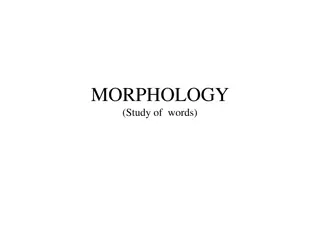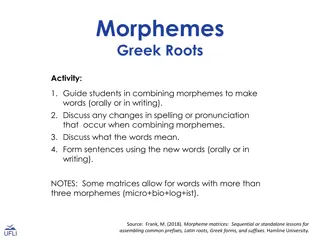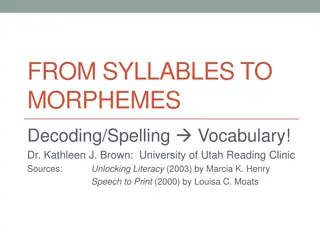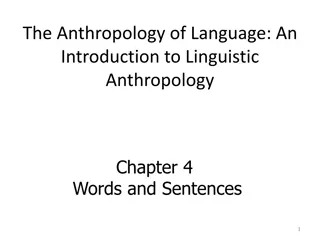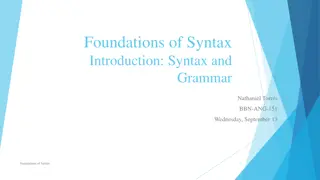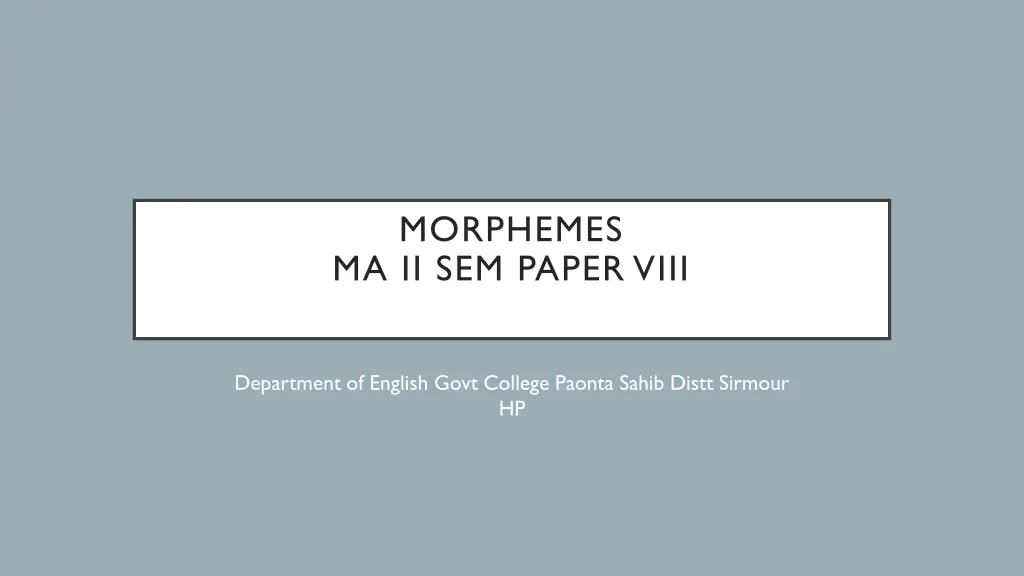
Understanding Morphemes in Linguistics: Form and Meaning Pairings
Explore the complex relationships between form and meaning in morphemes, crucial units of linguistic analysis. Learn how identical forms can have distinct meanings, and how historical origins shape our understanding of morphemic elements.
Download Presentation

Please find below an Image/Link to download the presentation.
The content on the website is provided AS IS for your information and personal use only. It may not be sold, licensed, or shared on other websites without obtaining consent from the author. If you encounter any issues during the download, it is possible that the publisher has removed the file from their server.
You are allowed to download the files provided on this website for personal or commercial use, subject to the condition that they are used lawfully. All files are the property of their respective owners.
The content on the website is provided AS IS for your information and personal use only. It may not be sold, licensed, or shared on other websites without obtaining consent from the author.
E N D
Presentation Transcript
MORPHEMES MA II SEM PAPER VIII Department of English Govt College Paonta Sahib Distt Sirmour HP
Morphemes are form/meaning pairings (where "form" = distinctive string of sounds). Morphemes can be roots or affixes, depending on whether they are the main part or dependent part of a word (cf. Roots vs. Affixes). It is important to recognize that there is no one-to-one correspondence between form and meaning, and that what counts for identification as a morpheme is both form AND meaning. Let's consider some potentially tricky situations that can arise in deciding whether we're dealing with a single morpheme or more than one:
1. Two different morphemes can accidentally have the same form. Some English morphemes for which this is the case are the following ("Greek prefix", "Latin root" etc. are abbreviations for "prefix borrowed from (Classical) Greek", "root morpheme borrowed from Latin" etc.): a indefinite article (native English--a free morpheme) a- 'not' (one form of a Greek prefix) in- 'not' (Latin prefix) ( insoluble, inclement ) in- 'into, within' (Latin prefix) ( ingress, invade ) homo 'human being' (Latin root) homo- 'same' (Greek prefix) The unrelatedness of the meanings tells us they are different linguistic units. There is no psychological connection between them, an
2. Forms with the same meaning may also be different morphemes. There are two subcases of this: the forms may be rather different from one another. Example: a-/an- 'not' (Greek prefix) in- 'not' (Latin prefix) (other allomorphs im-, il-, ir- , etc.) un- 'not' (native English prefix) In this example, the first two morphemes were borrowed into English from different languages, a sufficient reason for thinking of them as different elements and hence distinct morphemes. The third is native English, which means another different linguistic source and hence a different element. It so happens that in this case, all three morphemes go back to a prehistoric word meaning 'not' that linguists have reconstructed as part of the original language that gave rise to Latin, Greek, English, and other related languages. But the connection is too far back to think of them as a unitary element in English.
the forms may be the same or very similar, but like the above case, their sources are different languages. Example: in- 'into, within' (Latin prefix) in(-) 'into, within' (native English preposition and prefix) As above, these two happen to go back to a common ancestral source morpheme, before Latin and English (and their closest relatives) evolved into separate languages. (This historical fact accounts for why the forms are similar.) But again, the unity of these elements is only historical. Because the immediate source languages are different, it is reasonable to think of them as different elements. This kind of situation, in which our definition of morpheme as an element pairing a particular form with a particular meaning might lead us to call these one morpheme, but our historical knowledge leads us to call them two, is comparatively rare. We need not let such a borderline case detract from our basic understanding of a morpheme. They are mentioned here only for completeness' sake.
3. Two forms with the same meaning may be alternate forms of the same morpheme. Example: a- and an- 'not' (Greek prefix) se- and sed- 'apart' (Latin prefix) In these cases, the two forms are very similar, often differing in one consonant or vowel. They typically result from a situation in which an original single form adapted its beginning or ending sounds to the sounds found in other morphemes it combined with. Often there is some pattern to the alternation between the two forms (e.g. the Greek 'not' morpheme is found in the form a- before roots beginning with consonants, and an- before roots beginning with vowels.) The alternate forms in these cases are called allomorphs ( < Greek prefix allo- 'other'). We will discuss many cases of allomorphy in class; they are treated in Chapter 4 of Denning and Leben.





